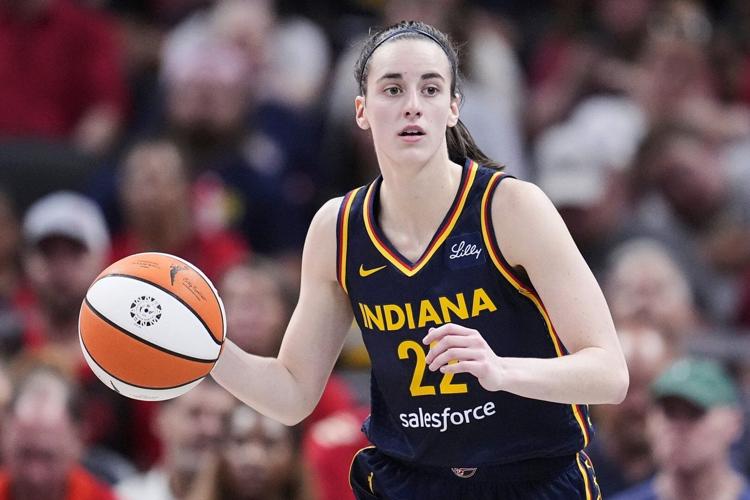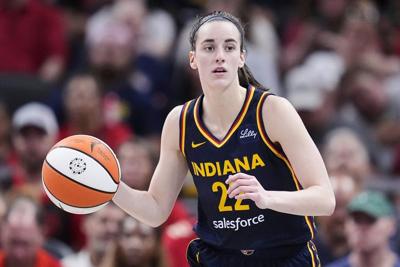WASHINGTON (AP) ŌĆö When Meghan Sells heads to Providence Park to watch Oregon’s professional women’s soccer team, she finds herself among a fairly mixed crowd ŌĆö groups of young women, dads bringing their children, youth players checking out the Thorns’ latest match.
The physicianŌĆÖs assistant is a self-described lifelong sports fan and former softball player who ŌĆ£will watch any sport.ŌĆØ That includes both collegiate and professional sports for women, putting Sells squarely in that suddenly has more options than ever before and is seen as fertile ground for teams and advertisers eager to ride the rising interest in the womenŌĆÖs game.
About 3 in 10 U.S. adults follow womenŌĆÖs professional or college sports ŌĆ£extremely,ŌĆØ “veryŌĆØ or ŌĆ£somewhatŌĆØ closely, according to a new poll from . That’s lower than the share who follow men’s sports by the same measurements ŌĆö about half ŌĆö but it also shows that Sells is far from alone.
As and in womenŌĆÖs sports have , so have the entry points for fans. The meteoric rise of Caitlin Clark, the University of Iowa phenom-turned-WNBA star, helped bring wider attention to women’s basketball, and , and have elevated and of women’s sports.
ŌĆ£Growing up, I feel like the only sports I was able to really see on TV were menŌĆÖs ŌĆö which is fine, I like menŌĆÖs sports,ŌĆØ Sells said. ŌĆ£But I enjoy watching womenŌĆÖs sports more. ... I think the more that you see it on TV, the more youŌĆÖre going to have younger people interested in it.ŌĆØ
The poll found that women’s sports fans ŌĆö those who follow women’s sports at least ŌĆ£somewhatŌĆØ closely ŌĆö are different from men’s sports fans. Fans of womenŌĆÖs sports, while not a majority-female group, are more gender balanced than menŌĆÖs sports fans. Those who follow women’s pro sports also are more casual in their fandom than men’s pro sports fans, tending to say they attend or watch games occasionally rather than frequently. People who follow men’s sports, by contrast, are more likely to identify attachments to teams as opposed to players.
The survey was conducted just before the start of the 2025 WNBA season, for the league. Coming off a season in which attendance records were set (and ), the league will debut a new franchise ŌĆö the Golden State Valkyries ŌĆö and up the number of regular season games from 40 to 44.
In 2026, two additional teams will join the league, including one in Portland, Oregon. Sells, who’s been in the city for about a decade, said she is prepared to get season tickets.
Different fan bases
MenŌĆÖs sports at both the collegiate and professional levels remain more popular than womenŌĆÖs sports, the poll found. About one-third of U.S. adults said they watch, listen to or read about menŌĆÖs collegiate sports at least ŌĆ£somewhatŌĆØ closely, and more than 4 in 10 say they follow menŌĆÖs pro sports. By contrast, about 2 in 10 say they follow women’s collegiate sports at least ŌĆ£somewhatŌĆØ closely, and a similar share say they follow womenŌĆÖs pro sports.
A greater share of men than women say they follow professional or collegiate sports overall, but the gender balance was more even among women’s sports fans. Around half of fans of womenŌĆÖs sports are male, the survey found, compared with about two-thirds of fans of menŌĆÖs sports.
This could be in part due to the overlap between the fandoms: About 90% of U.S. adults who follow womenŌĆÖs sports at least ŌĆ£somewhatŌĆØ closely also say the same about menŌĆÖs sports, though about half of people who follow menŌĆÖs sports said they also followed womenŌĆÖs sports.
As womenŌĆÖs sports increase in popularity and accessibility, a relatively large share are casual fans. While close to 9 in 10 of both menŌĆÖs and womenŌĆÖs pro sports fans say they frequently or occasionally watch, listen to or read about their respective professional sports, a higher percentage of womenŌĆÖs sports fans say they are only occasional consumers.
That includes people like Matthew Behr, 58, a lifelong fan of the Green Bay Packers and Milwaukee Brewers in his home state of Wisconsin. He doesnŌĆÖt watch a lot of basketball, he said, but when the sport crosses into news coverage, he will read up on it.
ThatŌĆÖs how he started following Clark, whose final seasons at Iowa were credited with and who now plays for the Indiana Fever.
ŌĆ£I was seeing it on MSNBC,ŌĆØ he said. ŌĆ£I donŌĆÖt watch a lot of basketball. ItŌĆÖs not a menŌĆÖs and womenŌĆÖs thing. If she was playing in a womenŌĆÖs football league, IŌĆÖd probably watch that.ŌĆØ
Attending games
MenŌĆÖs sports ŌĆö with larger leagues, bigger TV deals and a more expansive media ecosystem ŌĆö have a more fervent audience. About two-thirds of menŌĆÖs sports fans said they ŌĆ£frequentlyŌĆØ or ŌĆ£occasionallyŌĆØ attend a professional sporting event in person, compared with roughly half of womenŌĆÖs sports fans.
One possible reason womenŌĆÖs sports fans arenŌĆÖt showing up at sporting events is theyŌĆÖre less likely to be attached to a specific team. Only about one-third of womenŌĆÖs sports fans said the teams they support or follow are ŌĆ£extremelyŌĆØ or ŌĆ£veryŌĆØ important to why they follow the sport. For menŌĆÖs fans, the figure was around 50%.
However, nearly identical shares of menŌĆÖs and womenŌĆÖs sports fans said that certain athletes they support were at least ŌĆ£veryŌĆØ important to why they follow womenŌĆÖs sports.
Bernard Seltzer, a high school administrator and math and science teacher in Tampa, Florida, considers himself a general sports fan and said he enjoys watching the most skillful athletes, regardless of their gender. Even at the high school level, he is impressed by the finesse he sees female athletes demonstrate.
ŌĆ£Sometimes itŌĆÖs more impressive than watching masculine people banging their heads against the wall,ŌĆØ he said.
___
The AP-NORC poll of 1,260 adults was conducted April 17-21, using a sample drawn from NORCŌĆÖs probability-based AmeriSpeak Panel, which is designed to be representative of the U.S. population. The margin of sampling error for adults overall is plus or minus 3.9 percentage points.





























